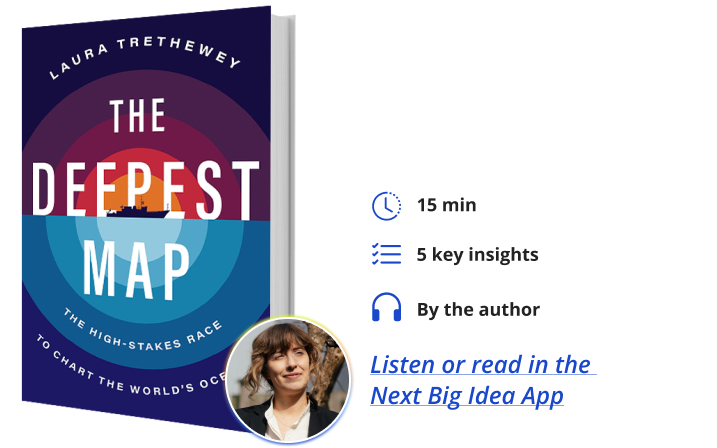Laura Trethewey is an award-winning environmental and ocean journalist. In 2020, the Writers’ Trust of Canada awarded her a Rising Star award. Her writing has been published and featured in the Wall Street Journal, Smithsonian Magazine, Courrier International, The Guardian, The Atlantic, and Canadian Geographic, among others. She received a master of fine arts in creative writing from the University of British Columbia and currently teaches creative nonfiction at Sheridan College in Ontario.
Below, Laura shares 5 key insights from her new book, The Deepest Map: The High-Stakes Race to Chart the World’s Oceans. Listen to the audio version—read by Laura herself—in the Next Big Idea App.

1. There’s danger in the deep.
The recent catastrophe of the Titan submersible implosion spotlighted the dangers of deep-sea tourism. Previously, deep-sea submersibles were off-limits to the public because only the military or scientific agencies could afford such expensive equipment. Today, the richest people in the world can pay for a personal trip to space or the deep sea.
In 2019, the Dallas multi-millionaire Victor Vescovo announced his intention to join these ranks of privately funded explorers. He wanted to become the first person to dive to the deepest points of all five oceans—and he wanted to dive alone. Patrick Lahey, the CEO of Triton Submarines who built Victor his specially designed submersible, absolutely hated the idea of Victor going alone. What would the team do if they lost contact with him beneath the surface? If the unthinkable happened, how would they retrieve his body thousands of feet below the surface?
About halfway through Victor’s first dive to the Atlantic’s deepest point, he missed a scheduled check-in with Patrick floating miles above on the support ship. “Victor, can you read me?” Patrick yelled into his headset again and again. Nothing but the soft wash of static filled the room. Twenty-five minutes of silence passed and then, suddenly, Victor’s voice crackled through the underwater communication system. He was fine; all systems go.
Unlike the uncertified Titan submersible, Victor paid a quarter of a million dollars to certify his sub and went on to successfully reach the bottom of the Atlantic, as well as the Pacific, Indian, Southern, and Arctic oceans, too. Danger in the deep is a given, so safety at sea should be too, particularly as deep-sea tourism expands in the future.
2. There’s a new world in the deep.
We know more about the moon than we do about the deep sea. As a journalist devoted to covering the ocean, I’ve lost count of how many times I’ve read this cliché, and yet it never fails to pique my curiosity. Why do we know so little about the seafloor? Why do we care more about exploring distant planets? Since the late 1960s, government support for ocean exploration has dwindled, while funding for space exploration has skyrocketed. Here’s one statistic for you: NASA’s investments in space exploration dwarf ocean exploration by more than 150 to 1.
The curious thing is that ocean exploration and space exploration have a lot in common. Take the gear, for starters. Deep-sea submersibles are built to withstand a parallel universe of bone-crushing barometric pressure, freezing temperatures, and corrosive salt water, just like rovers and rockets have to tolerate the harsh conditions of outer space. The two fields also share a hunt for extreme life. In the deep sea, there are animals and organisms that have evolved to live under intense pressure, without light or oxygen. These creatures could be a good analog for the aliens we might discover on distant planets. The outlook is a little similar, too. When Victor Vescovo sank to the bottom of all five oceans, he compared the plankton rushing past the porthole to the view of moving at warp speed as a rocket ship launches into space.
“NASA’s investments in space exploration dwarf ocean exploration by more than 150 to 1.”
We don’t need to blast off to Mars any time soon. With only a quarter of the global seafloor mapped and less than one percent explored, we already have another planet to explore right here on Earth.
3. There’s mystery in the deep.
Cassie Bongiovanni is the 25-year-old ocean mapper who worked with Victor Vescovo to discover the deepest points of all five oceans. That’s right—we didn’t even know where the deepest points on the planet were until Victor and Cassie decided to go find them.
Ocean mapping is often relegated to the world of shipping and safe navigation. But, as Cassie discovered during her year and a half at sea, there is so much more to ocean mapping than moving ships from port A to port B. There are fascinating mysteries down there, like the final resting place of Amelia Earhart’s plane and the Malaysian Airlines Flight 370. There are roughly three million shipwrecks scattered across the ocean floor, less than one percent of which have been explored. (The search for the MH370 turned up two 19th-century shipwrecks in the Indian Ocean.) There’s also human history buried on continental shelves. When the glaciers of the last Ice Age melted 10,000 years ago, a deluge of water drowned coastal landscapes equal to the size of South America. Early humans loved the coast just as much as we do. By mapping those sunken coastlines, we could answer big unresolved questions like when and how people first populated the Americas.
At the end of the Five Deeps Expedition, Victor and Cassie donated 400,000 square miles of seafloor maps to Seabed 2030: the global initiative that aims to finish the first public map of the seafloor. This map is just the jumping-off point for asking so many more interesting questions about our planet. As Cassie once said of her map: “This is only a taste of the science that’s out there.”
4. There’s money in the deep.
While some are eager to map the deep, there are many more who see dollar signs down there. Just as efforts are underway to finish the first map of the seafloor, there’s a larger push to open the underwater world to commercial mining, perhaps as soon as 2024. This issue couldn’t be more timely, because this July, a rule that has safeguarded the seafloor from commercial mines will expire, and the governments of the world will soon meet to discuss issuing the first permits.
“The fragile deep-sea world is not another frontier to map, mine, and throw away.”
The leap from map to mine might sound inevitable, even predictable, to some. As the journalist Stephen Hall once wrote: “A map always presages some form of exploitation.” This is especially true of new frontiers where our knowledge is sparse. Although there are many examples throughout history of maps paving the way for extraction, there are important exceptions. In the years following World War II, shortly after Antarctica was mapped for the first time, the international community rallied together and signed a treaty that conserves this vast, uninhabited continent for science. The businessman Victor Vescovo came away from his time exploring the deep as an ardent opponent to mining and extraction. The fragile deep-sea world is not another frontier to map, mine, and throw away. It’s a foundational environment whose importance we’ve only begun to fathom.
5. There’s humanity in the deep.
How can there be humanity on the deep, dark, dangerous seafloor? As it turns out, all life on Earth began at the seafloor, likely at a hydrothermal vent. In 1977, a team of marine scientists stumbled upon the first one, along with a huge cluster of mussels, clams, and crabs feasting off the minerals spewing up from the underwater hot spring. Like so many discoveries in the deep, this was a major and accidental find. Until then, the generally accepted wisdom was that all life was photosynthetic and dependent on the sun for energy. Suddenly, a new chemosynthetic existence hove into view—one that had the power to upend everything we know about life on Earth.
Since that first discovery, researchers have uncovered more than 600 vent fields across the global ocean. We don’t know which vent exactly gave birth to life on Earth, but there are some good candidates, like the Lost City in the Atlantic. With its spiraling, smoking chimneys rising 200 feet from the seafloor, the Lost City looks right out of The Lord of the Rings—and it could hold the secret to humanity’s earliest origin. Mapping the seafloor is ultimately a quest to understand ourselves.
To listen to the audio version read by author Laura Trethewey, download the Next Big Idea App today:





























